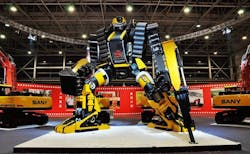How the Fourth Industrial Revolution will alter the globe’s workforce
Nanotechnology, artificial intelligence, 3D printing, biotechnology, machine-learning, robotics, genetic editing. These are among the so-called “cyber-physical” business fields that are swiftly pulling the world’s economies into the next great technological metamorphosis: the Fourth Industrial Revolution.
This coming era of radical transformation follows, of course, the first three industrial revolutions: the rise of machines (steam, water, and mechanical production equipment) in the 1780s; the birth of mass production and electricity in the 1870s; and the development of electronics, IT, and automated production in the late 1960s.
This next cycle will be “unlike anything humankind has experienced before,” due to the sheer size, speed, and scope of disruption, writes Klaus Schwab, Founder and Executive Chairman of the World Economic Forum (WEF), in his new book, “The Fourth Industrial Revolution."
The world’s largest taxi company—Uber—didn’t exist seven years ago. It operates in 68 countries and is valued at $62 billion, even though it doesn’t own a single vehicle. The globe’s biggest lodging provider—Airbnb—was founded just eight years ago. It hosts more than 1.5 million listings in 34,000 cities and 190 countries. It owns zero real estate, yet holds a $25 billion market valuation.
In today’s digital, interconnected world, Schwab writes, change evolves at an exponential, rather than a linear, pace. And disruption occurs at mass scale, spanning across countries, industries, and society as a whole. The world’s largest taxi company—Uber—didn’t exist seven years ago. It operates in 68 countries and is valued at $62 billion, even though it doesn’t own a single vehicle. The globe’s biggest lodging provider—Airbnb—was founded just eight years ago. It hosts more than 1.5 million listings in 34,000 cities and 190 countries. It owns zero real estate, yet holds a $25 billion market valuation.
The list goes on: Alibaba, Amazon, Facebook, Google, Twitter—all have experienced hyper growth, at mass scale, and with relatively little overhead. Take, for example, a comparison of the three largest companies in Detroit in 1990 (while still in its manufacturing boom days) versus Silicon Valley’s three biggest firms in 2014: The tech-based companies required nine times fewer employees (about 137,000) than the manufacturing-based companies (1.2 million) to generate the same revenues, roughly $250 billion. The automation inherent in digital services means many tech-based companies do not incur dramatic diminishing returns when scaling up, writes Schwab.
What does this chaotic remake of traditional business models mean for tomorrow’s workforce? Business, political, and academic leaders—including Schwab—wrestled with this question during the annual WEF summit last week in Davos, Switzerland. Among their conclusions—which were presented in a research report, “The Future of Jobs”—were:
• In the near term (2015-2020), there could be a net loss of 5.1 million jobs worldwide to disruptive labor market changes, a large portion in the office and admin functions.
• Experts forecast a total gain of two million jobs in the computer and mathematical and architecture and engineering fields by 2020 (good news for AEC!).
• Two emerging job types stand out: data analysts, to help companies make sense of the torrent of information, and specialized sales reps., to help firms commercialize their services.
Schwab’s chief concern, though, is the exacerbation of inequality worldwide, as the money and resources flow through an ever-shrinking number of entities.
About the Author

David Barista
David Barista is Editorial Director of Building Design+Construction and BDCnetwork.com, properties that combined reach more than 100,000 commercial building professionals, including architects, engineers, contractors, and building owners. David has covered the U.S. construction industry for more than a decade, previously serving as Editor-in-Chief of BD+C, Professional Builder, Custom Builder, and HousingZone.com. He has won numerous editorial awards, including six Jesse H. Neal Awards and multiple honors from the Construction Writers Association and the American Society of Business Publication Editors.
Email: [email protected]
